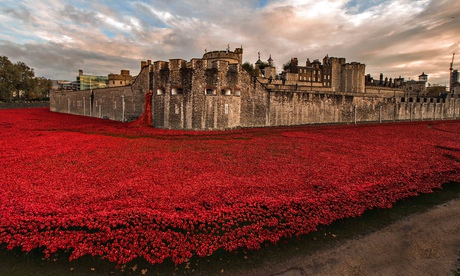
In England, on this day, at the 11th hour of the 11th day, of the 11th month, we mark the moment the guns fell silent and the First World War ended. On Armistice day, to commemorate the fallen we wear poppies, the first flower to bloom on the battle blasted fields of war, their flimsy blood red petals springing up from the blood-soaked land.
Never has the significance of the poppy been so movingly captured than in a 2014 art installation at The Tower of London. Entitled ‘Blood Swept Lands and Seas of Red’, two artists, with the help of 21, 688 volunteers ‘planted’ 888,246 ceramic poppies around the Tower – one poppy for each British and colonial life lost during WW1.
The unforgettable sight a strange mix of beauty and poignancy.
From a red sea of poppies to a “green sea” of poisoned gas in Wilfred Owen’s poem ‘Dulce et Decorum est’…
Considered by many the greatest poet of WW1 Owen’s poetry captures the horror of war with the unforgiving eye of one living through it. (Finally, he didn’t live through it, he died at 25, a week before the Armistice.)

In contrast to the patriotic verse that regularly glamorised the life and death of a solider Owen launches a scathing attack on the casual romanticism of war embodied in the Latin phrase of the title. (“it is sweet and fitting to die for one’s country”).
Christopher Hitchens’ reading of the poem remains for me the most powerful. The listener is almost unaware that he has started the poem, so natural is the delivery of lines learnt by heart. Urgently taken into a confidence, we are drawn in until that quietly devastating finish:
‘My friend, you would not tell with such high zest
To children ardent for some desperate glory,
The old Lie: Dulce et decorum est
Pro patria mori”


